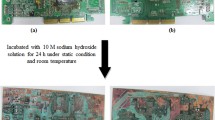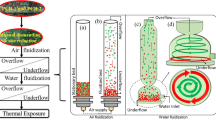Abstract
In the present study, the leaching of metals from large pieces of computer printed circuit boards (CPCBs) was studied. A combination of citric acid (0.5 M) and 1.76 M hydrogen peroxide (H2O2) was used to leach the metals from CPCB piece. The influence of system variables such as H2O2 concentration, concentration of citric acid, shaking speed, and temperature on the metal leaching process was investigated. The complete metal leaching was achieved in 4 h from a 4 × 4 cm CPCB piece. The presence of citric acid and H2O2 together in the leaching solution is essential for complete metal leaching. The optimum addition amount of H2O2 was 5.83 %. The citric acid concentration and shaking speed had an insignificant effect on the leaching of metals. The increase in the temperature above 30 °C showed a drastic effect on metal leaching process.





Similar content being viewed by others
References
Adhapure N, Dhakephalkar P, Dhakephalkar A, Tembhurkar V, Rajgure A, Deshmukh A (2014) Use of large pieces of printed circuit boards for bioleaching to avoid ‘precipitate contamination problem’ and to simplify overall metal recovery. MethodsX 1:181–186
Adhapure N, Waghmare S, Hamde V, Deshmukh A (2013) Metal solubilization from powdered printed circuit boards by microbial consortium from bauxite and pyrite ores. Appl Biochem Microbiol 49:256–262
Akcil A, Ceren E, Chandra S, Mehmet O, Merve S, Aysenur T (2015) Precious metal recovery from waste printed circuit boards using cyanide and non-cyanide lixiviants—a review. Waste Manag 45:258–271
Arshadi M, Mousavi S (2014) Simultaneous recovery of Ni and Cu from computer-printed circuit boards using bioleaching: statistical evaluation and optimization. Bioresour Technol 174:233–242
Askari A, Ghadimzadeh A, Gomes C, Ishak M (2014) E-waste management: towards and appropriate policy. Eur J Bus Manage 6:37–46
Birloaga I, De-Michelis I, Ferella F, Buzatu M, Vegliò F (2013) Study on the influence of various factors in the hydrometallurgical processing of waste printed circuit boards for copper and gold recovery. Waste Manag 33:935–941
Cayumil R, Khanna R, Ikram-Ul-Haq M, Rajarao R, Hill A, Sahajwalla V (2014) Generation of copper rich metallic phases from waste printed circuit boards. Waste Manag 34:1783–1792
Deveci H, Yazici E, Aydın U, Akçil A (2010) Extraction of copper from scrap TV boards by sulphuric acid leaching under oxidizing conditions. Going Green-CARE INNOVATION. Vienna, Austria, Paper no: 045.
Goyne W, Brantley L, Chorover J (2010) Rare earth element release from phosphate minerals in the presence of organic acids. Chem Geol 278:1–14
Jadhav U, Hocheng H (2015b) Hydrometallurgical recovery of metals from large printed circuit board pieces. Scientific Reports. doi:10.1038/srep14574
Kinoshita T, Akita S, Kobayashi N, Nii S, Kawaizumi F, Takahashi K (2003) Metal recovery from non-mounted printed wiring boards via hydrometallurgical processing. Hydrometallurgy 69:73–79
Kolenčík M, Urík M, Čerňanský S, Molnárová M, Matúš P (2013) Leaching of zinc, cadmium, lead and copper from electronic scrap using organic acids and the Aspergillus niger strain. Fresenius Environ Bull 22:3673–3679
Kumar M, Lee J, Kim M, Jeong J, Yoo K (2014) Leaching of metals from waste printed circuit boards (wpcbs) using sulfuric and nitric acids. Environ Eng Manag J 13:2601–2607
Li L, Jing G, Feng W, Renjie C, Shi C, Borong W (2010a) Recovery of cobalt and lithium from spent lithium ion batteries using organic citric acid as leachant. J Hazard Mater 176:288–293
Li L, Jing G, Renjie C, Feng W, Shi C, Xiaoxiao Z (2010b) Environmental friendly leaching reagent for cobalt and lithium recovery from spent lithium-ion batteries. Waste Manag 30:2615–2621
Li H, Yeager C, Brinkmeyer R, Zhang S, Ho Y, Xu C et al (2012) Bacterial production of organic acids enhances H2O2-dependent iodide oxidation. Environ Sci Technol 46:4837–4844
Mecucci A, Scott K (2002) Leaching and electrochemical recovery of copper, lead and tin from scrap printed circuit boards. J Chem Technol Biotechnol 77:449–457
Moffett J, Zika R (1987) Reaction kinetics of hydrogen peroxide with copper and iron in seawater. Environ Sci Technol 21:804–810
Park Y, Fray D (2009) Recovery of high purity precious metals from printed circuit boards. J Hazard Mater 164:1152–1158
Saidan M, Brown B, Valix M (2012) Leaching of electronic waste using biometabolised acids. Chinese. J Chem Eng 20:530–534
Samina M, Karim A, Venkatachalam A (2011) Corrosion study of iron and copper metals and brass alloy in different medium. Electronic. J Chem 8:344–348
Sonmez M, Kumar R (2009) Leaching of waste battery paste components. Part 1: lead citrate synthesis from PbO and PbO2. Hydrometallurgy 95:53–60
Steer J, Griffiths A (2013) Investigation of carboxylic acids and non-aqueous solvents for the selective leaching of zinc from blast furnace dust slurry. Hydrometallurgy 140:34–41
Tuncuk A, Stazi V, Akcil A, Yazici E, Deveci H (2012) Aqueous metal recovery techniques from e-scrap: hydrometallurgy in recycling. Miner Eng 25:28–37
Wasay S, Barrington S, Tokunaga S (2001) Organic acids for the in situ remediation of soils polluted by heavy metals: soil flushing in columns. Water Air Soil Poll 127:301–314
Yang H, Jingyang L, Jiakuan Y (2011) Leaching copper from shredded particles of waste printed circuit boards. J Hazard Mater 187:393–400
Yazici E, Deveci H (2014) Ferric sulphate leaching of metals from waste printed circuit boards. Int J Miner Process 133:39–45
Acknowledgments
The current research is supported by the National Science Council of Taiwan under contract MOST 103-2221-E-007-136-MY3.
Author information
Authors and Affiliations
Corresponding author
Additional information
Responsible editor: Philippe Garrigues
Electronic supplementary material
ESM 1
(DOC 171 kb)
Rights and permissions
About this article
Cite this article
Jadhav, U., Su, C. & Hocheng, H. Leaching of metals from large pieces of printed circuit boards using citric acid and hydrogen peroxide. Environ Sci Pollut Res 23, 24384–24392 (2016). https://doi.org/10.1007/s11356-016-7695-9
Received:
Accepted:
Published:
Issue Date:
DOI: https://doi.org/10.1007/s11356-016-7695-9




